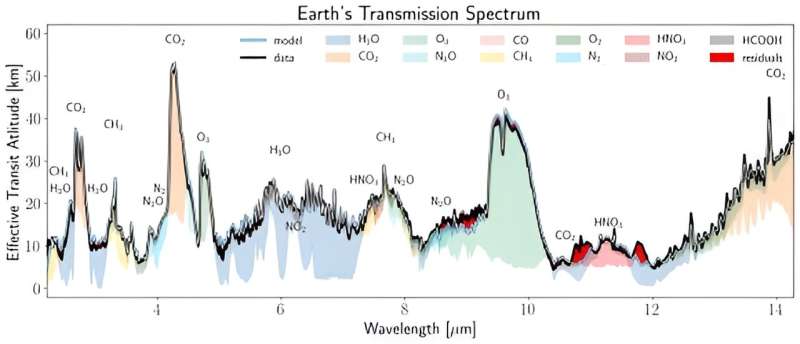This article has been reviewed according to Science X's editorial process and policies. Editors have highlighted the following attributes while ensuring the content's credibility:
fact-checked
preprint
trusted source
proofread
If Earth were an exoplanet, JWST would know there's an intelligent civilization here

If we're going to look for life on other worlds, why not start with the one planet we know has life? Earth's atmosphere is rich with oxygen and molecules such as methane, which strongly suggest the presence of life. It also has traces of molecules such as nitrogen dioxide and CFCs (commonly known as freon) which are strong indicators of an industrial civilization.
As a recent study shows, if Earth were an exoplanet, James Webb Space Telescope (JWST) could identify these molecules in our atmosphere. The study is published on the arXiv pre-print server.
The study starts with real observations of Earth's atmosphere. The Canadian satellite SCISAT took high-resolution spectra of sunlight passing through a cloudless region of Earth's atmosphere, and from this identified a range of natural and synthetic molecules.
Using an averaging of the data across different atmospheric depths, an earlier study simulated the possible spectra as it would appear when Earth transits the sun seen from the outer solar system. This provides a good baseline for what exoplanet data could be obtained.
The authors then took this to the next level by "roughing up" the data, adding simulated noise to the signal, and then sampling it at lower resolutions. This is similar to the kind of observations JWST would make on an exoplanet light-years away.
The goal was to determine if enough data could still be captured to identify atmospheric models, even when the observations are faint and noisy. Sure enough, the signal-to-noise ratio was strong enough to identify many of the molecules for an Earth-like exoplanet within 50 light-years of Earth.
The team then took the idea a step further and considered the exoplanet system known as Trappist-1. It's a system 40 light-years away with seven known planets, two or three of which are potentially habitable. By introducing molecular spectra into the simulated spectra of Trappist worlds, the team showed that JWST could identify both biological signatures and technological signatures should they exist on a Trappist exoplanet.
We still wouldn't be able to identify alien structures on this world, but we don't need to go that far to prove the existence of aliens. If JWST can identify oxygen, organic molecules, and synthetic molecules such as CFCs in the atmosphere of a nearby exoplanet, then we know an intelligent civilization either is or was present there. That would be a tremendous step forward in our understanding of life in the universe.
More information: Jacob Lustig-Yaeger et al, Earth as a Transiting Exoplanet: A Validation of Transmission Spectroscopy and Atmospheric Retrieval Methodologies for Terrestrial Exoplanets, arXiv (2023). DOI: 10.48550/arxiv.2308.14804
Journal information: arXiv
Provided by Universe Today





















